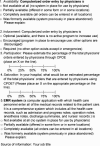Computerized physician order entry and electronic medical record systems in Korean teaching and general hospitals: results of a 2004 survey
- PMID: 16049229
- PMCID: PMC1294035
- DOI: 10.1197/jamia.M1768
Computerized physician order entry and electronic medical record systems in Korean teaching and general hospitals: results of a 2004 survey
Abstract
Objective: To determine the availability of computerized physician order entry (CPOE) and electronic medical record (EMR) systems in teaching and general hospitals in the Republic of Korea.
Design: A combined mail and telephone survey of 283 hospitals.
Measurements: The surveys assessed the availability of CPOE and EMRs in the hospitals, as well as inducement, participation, and saturation regarding CPOE use by physicians.
Results: A total of 122 (43.1%) hospitals responded to the survey. The complete form of CPOE was available in 98 (80.3%) hospitals. The use of CPOE was mandatory in 92 (86.0%) of the 107 hospitals that responded to the questions regarding the requirement of CPOE use. In 85 (79.4%) of the hospitals in which CPOE was in use, more than 90% of physicians used the system. In addition, physicians entered more than 90% of their total orders through CPOE in 87 (81.3%) hospitals. In contrast, a complete EMR system was available in only 11 (9.0%) of the hospitals.
Conclusion: Of the teaching and general hospitals in the Republic of Korea that responded to the survey, the majority (80.3%) have CPOE systems, and a complete EMR system is available in only 9%.
Figures





Similar articles
-
Computerized physician order entry in U.S. hospitals: results of a 2002 survey.J Am Med Inform Assoc. 2004 Mar-Apr;11(2):95-9. doi: 10.1197/jamia.M1427. Epub 2003 Nov 21. J Am Med Inform Assoc. 2004. PMID: 14633935 Free PMC article.
-
Adoption of electronic health records in Korean tertiary teaching and general hospitals.Int J Med Inform. 2012 Mar;81(3):196-203. doi: 10.1016/j.ijmedinf.2011.12.002. Epub 2011 Dec 27. Int J Med Inform. 2012. PMID: 22206619
-
Early adopters of computerized physician order entry in hospitals that care for children: a picture of US health care shortly after the Institute of Medicine reports on quality.Clin Pediatr (Phila). 2009 May;48(4):389-96. doi: 10.1177/0009922809331801. Epub 2009 Feb 17. Clin Pediatr (Phila). 2009. PMID: 19224864
-
Computerized physician order entry in the critical care environment: a review of current literature.J Intensive Care Med. 2011 May-Jun;26(3):165-71. doi: 10.1177/0885066610387984. Epub 2011 Jan 21. J Intensive Care Med. 2011. PMID: 21257633 Review.
-
A detailed description of the implementation of inpatient insulin orders with a commercial electronic health record system.J Diabetes Sci Technol. 2014 Jul;8(4):641-51. doi: 10.1177/1932296814536290. Epub 2014 May 25. J Diabetes Sci Technol. 2014. PMID: 24876450 Free PMC article. Review.
Cited by
-
Methods to evaluate health information systems in healthcare settings: a literature review.J Med Syst. 2007 Oct;31(5):397-432. doi: 10.1007/s10916-007-9082-z. J Med Syst. 2007. PMID: 17918694 Review.
-
Adoption rates of electronic health records in Turkish Hospitals and the relation with hospital sizes.BMC Health Serv Res. 2020 Oct 21;20(1):967. doi: 10.1186/s12913-020-05767-5. BMC Health Serv Res. 2020. PMID: 33087106 Free PMC article.
-
Factors affecting electronic medical record system adoption in small korean hospitals.Healthc Inform Res. 2014 Jul;20(3):183-90. doi: 10.4258/hir.2014.20.3.183. Epub 2014 Jul 31. Healthc Inform Res. 2014. PMID: 25152831 Free PMC article.
-
Computerised order entry systems and pathology services--a synthesis of the evidence.Clin Biochem Rev. 2006 May;27(2):79-87. Clin Biochem Rev. 2006. PMID: 17077878 Free PMC article.
-
Basic electronic health record (EHR) adoption in **Türkiye is nearly complete but challenges persist.BMC Health Serv Res. 2023 Sep 14;23(1):987. doi: 10.1186/s12913-023-09859-w. BMC Health Serv Res. 2023. PMID: 37710253 Free PMC article.
References
-
- Bates DW, Leape LL, Cullen DJ, et al. Effect of computerized physician order entry and a team intervention on prevention of serious medication errors. JAMA. 1998;280:1311–6. - PubMed
-
- Dexter PR, Perkins S, Overhage JM, Maharry K, Kohler RB, McDonald CJ. A computerized reminder system to increase the use of preventive care for hospitalized patients. N Engl J Med. 2001;345:965–70. - PubMed
-
- Teich JM, Merchia PR, Schmiz JL, Kuperman GJ, Spurr CD, Bates DW. Effects of computerized physician order entry on prescribing practices. Arch Intern Med. 2000;160:2741–7. - PubMed
Publication types
MeSH terms
LinkOut - more resources
Full Text Sources

